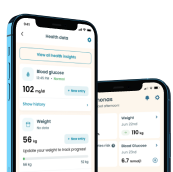What Are Leafy Greens?

If you’re making an effort to create a healthy lifestyle and follow a nutritious diet, you’ve probably heard of the health benefits of leafy greens. While you may recognize that it’s important to incorporate green leafy vegetables into your diet, you might not know what foods fall under this category. Here, learn the answer to, “What are leafy greens?” as well as some information on the specific health benefits of these superfoods.
What Constitutes a Leafy Green?
It’s no secret that leafy greens are healthy, but you may not know exactly what vegetables fall under this category. Some of the healthiest leafy green vegetables are listed below:
- Kale
- Collard greens
- Broccoli
- Cabbage
- Beet greens
- Watercress
- Mustard greens
- Arugula
- Romaine lettuce
- Swiss chard
- Endive
- Brussels sprouts
- Bok choy
What all of these vegetables have in common is that they come from plants with edible leaves, and as their name suggests, they can be identified by their green color. Some leafy greens like spinach can be consumed raw, whereas cooked collard greens are preferred, since they have a bitter flavor and tend to taste better when steamed.
Eating leafy greens like the ones above can be part a nutritious diet that supports a healthy lifestyle.
Nutrition Content of Leafy Greens
So, why eat leafy greens? You’ve probably heard of the health benefits of leafy greens, which come from their rich nutritional profile. According to nutrition experts, green leafy vegetables are rich in important nutrients, including vitamins A, C, E, and K. Some leafy greens are also an excellent source of the B vitamins, and many of them provide a healthy dose of fiber, iron, potassium, magnesium, and calcium.
Beyond these micronutrients, green leafy vegetables are known for being high in antioxidants and carotenoids, which can protect the cells and reduce the risk of cancer. What makes leafy greens so beneficial for health is that they pack a powerful nutritional punch, while being low in sodium, carbohydrates, and cholesterol. This means that they can be incorporated into numerous diets, including those for individuals with health problems like diabetes.
Finally, leafy greens contain dietary nitrates, which are believed to have numerous health benefits.
While leafy greens as a whole come packed with nutrition, the specific nutritional content will vary between specific types of leafy green vegetables.
Consider the nutrition facts of various leafy greens below:
Kale

As a member of the cabbage family, kale comes with the following nutritional content per cup, cooked:
- 43 calories
- 6 grams carbohydrates
- 1 gram sugar
- 1 gram fat
- 3.5 grams protein
- 5 grams fiber
Spinach

Packed with iron, magnesium, folic acid, and calcium, spinach is a true superfood. It’s also rich in beta carotene and can promote eye health. Beyond these benefits, a cup of spinach includes the following nutritional profile:
- 7 calories
- 1 gram carbohydrates
- Trivial amounts of fat and sugar
- 1 gram of protein
- 1 gram of fiber
Watercress

Cruciferous vegetables like watercress protect the body from cancer cell growth and other damage. A cup of watercress includes the following:
- 4 calories
- Under half a gram of carbohydrates
- 1 gram of protein
- Trivial amounts of fat, sugar and fiber
Romaine Lettuce

A favorite in salads, romaine lettuce is a good source of beta carotene and other antioxidants which can boost the immune system. A cup of romaine lettuce boasts the following nutrition facts:
- 8 calories
- 2 grams carbohydrates
- 1 gram sugar
- 1 gram protein
- 1 gram fiber
- A trivial amount of fat
Arugula

Arugula is also among the cruciferous vegetables, and it is often eaten raw, as it has a pleasant peppery flavor. People may also put it in soups or pasta dishes. The nutrition facts for a one-cup serving of arugula are as follows:
- 3 calories
- Under half a gram of carbohydrates
- Trivial amounts of fat, protein, sugar, and fiber
Swiss Chard

Swiss chard is rich in polyphenols, which can stop cancer cell growth. A cup of Swiss chard contains:
- 7 calories
- 1 gram carbohydrates
- Less than one gram of sugar and fat
- Half a gram of protein and fiber
Bok Choy
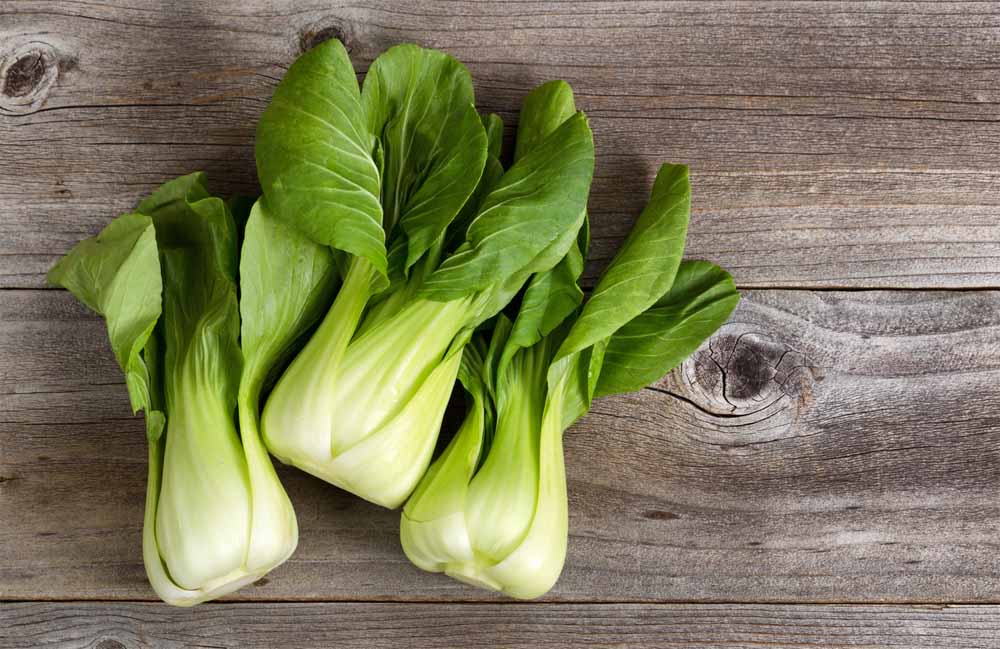
Referred to as Chinese cabbage, this cruciferous vegetable contains the following in each one-cup serving:
- 9 calories
- 1.5 grams carbohydrates
- 1 gram sugar
- 1 gram protein
- Almost 1 gram of fiber
- A trivial amount of fat
Cabbage

While cabbage can sometimes be purple or white, it can also have green leaves, making it a member of the class of leafy green vegetables. A one-cup serving of this cruciferous vegetable contains the following:
- 22 calories
- 5 grams carbohydrates
- 3 grams sugar
- A trivial amount of fat
- 1 gram of protein
- 2 grams of fiber
What you probably notice when reviewing the nutrition facts of leafy green vegetables is that they are all low in calories, carbs, and sugar. This makes them an important part of a healthy diet. Raw greens and other leafy greens are packed with nutrition, but because they do not contain many calories, you can eat large portions to fill you up, so you get the fuel you need without overdoing it on calories. Their low sugar and carb content also makes them suitable for a diabetes diet.



Specific Health Benefits of Leafy Greens
It’s pretty clear that green leafy vegetables like romaine lettuce and raw spinach are full of nutrients, and along with this nutrition profile come specific health benefits. Consider some of the health benefits of leafy greens below:
- Veggies with dark green leaves are packed with vitamin K, which reduces inflammation and improves bone health, thereby lowering the risk of osteoporosis.
- Antioxidants in leafy greens can reduce the risk of stomach, breast, and skin cancer and lower the risk of heart disease.
- The fiber content in green leafy veggies helps with digestion and weight management, making these vegetables beneficial for people with type 2 diabetes.
- Leafy green vegetables promote skin health, as research has shown that consuming them leads to reduced risk of skin cancer.
- Leafy greens contain beta carotene, which promotes eye health and can reduce the risk of macular degeneration.
Research With Leafy Greens
Since leafy greens have gotten so much attention for their role in a healthy diet, researchers have conducted studies to determine the exact benefits of these veggies. Studies have shown that eating more leafy greens does reduce the risk of breast cancer. In fact, a study in the journal Breast Cancer Research and Treatment found that eating more leafy vegetables reduced the risk of breast cancer by 30 percent!
Leafy greens can also lower the risk of heart disease. A new study in the European Journal of Epidemiology found that eating about one cup of leafy green vegetables per day reduces the risk of heart disease and lowers the incidence of hospitalizations linked to heart failure, stroke, and peripheral artery disease.
The beneficial effects of eating more leafy green vegetables are so strong that a review of 95 different studies showed that these veggies reduce the risk of heart disease and lower the risk of death from any cause.
Additional studies have shown that green leafy vegetables can reduce the risk of developing diabetes, because of their nutritional profile. For those who have diabetes, leafy greens may assist with blood sugar regulation, as animal research has shown that extracts from leafy green vegetables can lower blood glucose levels.
Adding Leafy Greens to Your Diet
If the idea of eating cooked spinach or raw greens on their own doesn’t seem too appealing, the good news is that you can incorporate leafy greens into your diet by adding them to some of your favorite dishes. Consider the following ways to incorporate leafy green vegetables into simple dishes you’re probably already making:
- Make a wrap that combines a lean meat like turkey or chicken, and throw in your favorite leafy greens, like romaine lettuce or swiss chard to add some crunch.
- Toss some spinach into your morning omelet or scrambled eggs.
- Throw together a salad with a variety of greens, such as kale, mustard greens, and swiss chard.
- Use stir fry greens like broccoli or bok choy and mix with chicken for a healthy homemade Asian-inspired dish.
- Steam collard or mustard greens and serve them as a side dish with dinner.
- Make green smoothies, and mix some of your favorite leafy greens with powerhouse fruits like blueberries or raspberries.
- Put leafy greens like bok choy and Swiss chard into homemade soups.
- Place greens on top of a pizza for a healthier version of this classic dish.
Healthy Recipes Including Leafy Greens
Throwing leafy greens into your favorite dishes is an easy way to incorporate these vegetables into your diet, but if you’re looking to try something new, consider the healthy recipes below.
Baked Kale Chips
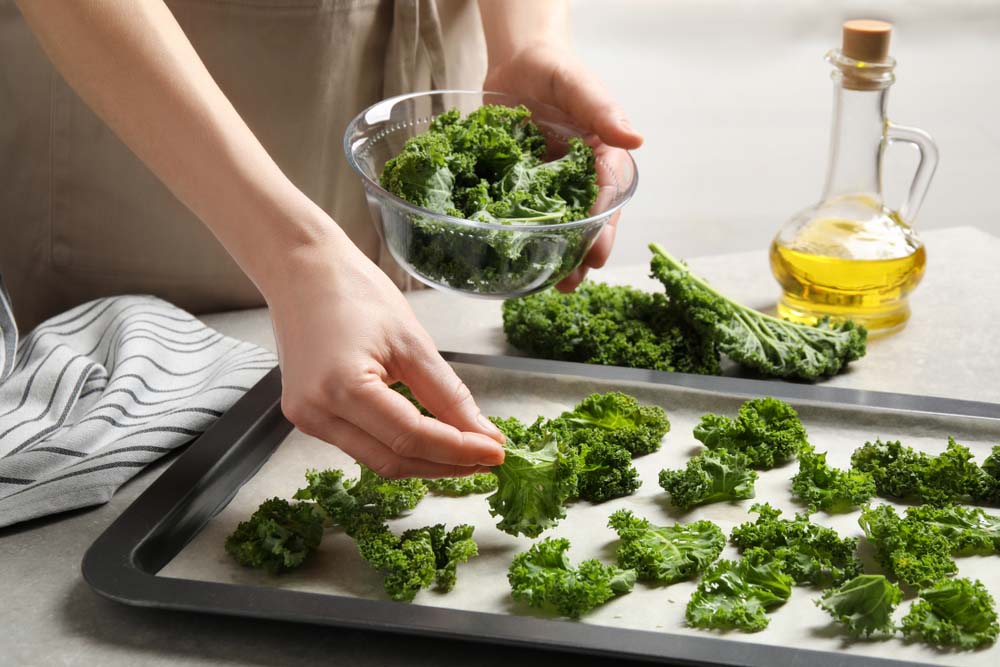
For this simple recipe, you’ll need just three ingredients: one bunch of kale, 1 tablespoon of olive oil, and 1 teaspoon of sea salt.
Follow these steps to prepare:
- Preheat the oven to 300 degrees, and line a baking sheet with parchment paper.
- Remove kale leaves from the stems with kitchen shears, and break into bite-sized pieces.
- Wash and dry the kale leaves in a salad spinner.
- Drizzle olive oil on the kale leaves and sprinkle with salt, and then toss.
- Bake for 2o to 30 minutes, or until edges start to brown.
Caesar Salad

Caesar salads are an excellent way to eat more leafy greens. Toss one at home with one large head of romaine lettuce, parmesan cheese, croutons, and homemade salad dressing.
The following steps are required for this recipe:
- Whisk together minced garlic, dijon, Worcestershire, lemon juice, and red wine vinegar, and then add in olive oil while continuing to whisk. Then, season with salt and pepper to taste.
- Combine all ingredients in a large mixing boil, and then toss in the dressing, mixing until the salad is evenly coated in dressing.
This Caesar salad makes an excellent side dish. If you’d like to turn it into a full lunch or dinner, consider adding some strips of grilled chicken for a healthy dose of protein.
Swish Chard & Tahini Dip
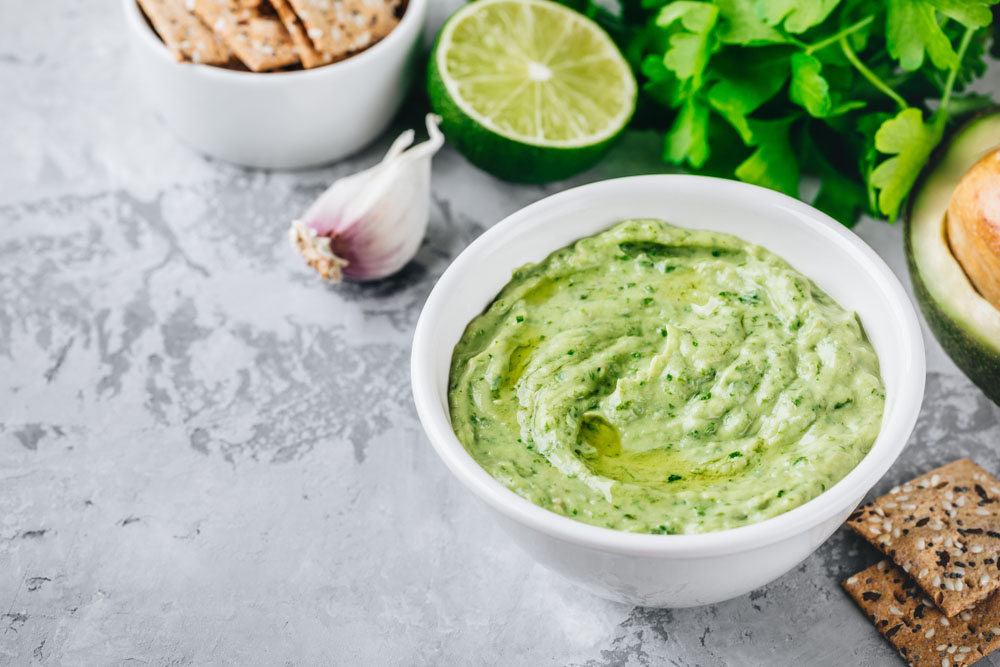
For those who love hummus, this dip will hit the spot. Ingredients include 2 bunches of Swiss chard, 2/3 cup olive oil, 5 finely chopped garlic cloves, 1/2 cup Tahini, 1/3 cup fresh lemon juice, Kosher salt, toasted flatbread, and lemon wedges.
To make, follow the recipe below:
- Separate ribs and stems from the Swiss Chard and finely chop. Separately, tear Swiss chard leaves into small pieces.
- On medium-low heat, heat up 1/3 cup of olive oil.
- Cook Swiss chard ribs and stems for 5-7 minutes, until tender, stirring often. Add in garlic and cook while stirring for one minute.
- Add one handful of Swiss chard leaves at a time, and add another handful once the previous handful begins to wilt. Cook, while tossing, for 10-12 minutes.
- Let the Swiss chard cool, and remove excess liquid.
- Put Swiss chard and 1 tablespoon of cooking liquid in the food processor. Add tahini, lemon juice, and 1/3 cup olive oil. Season with salt and then process until the dip is creamy.
- Place the dip in a serving boil and drizzle with olive oil.
- Serve dip with flatbread and lemon wedges.
Sautéed Bok Choy
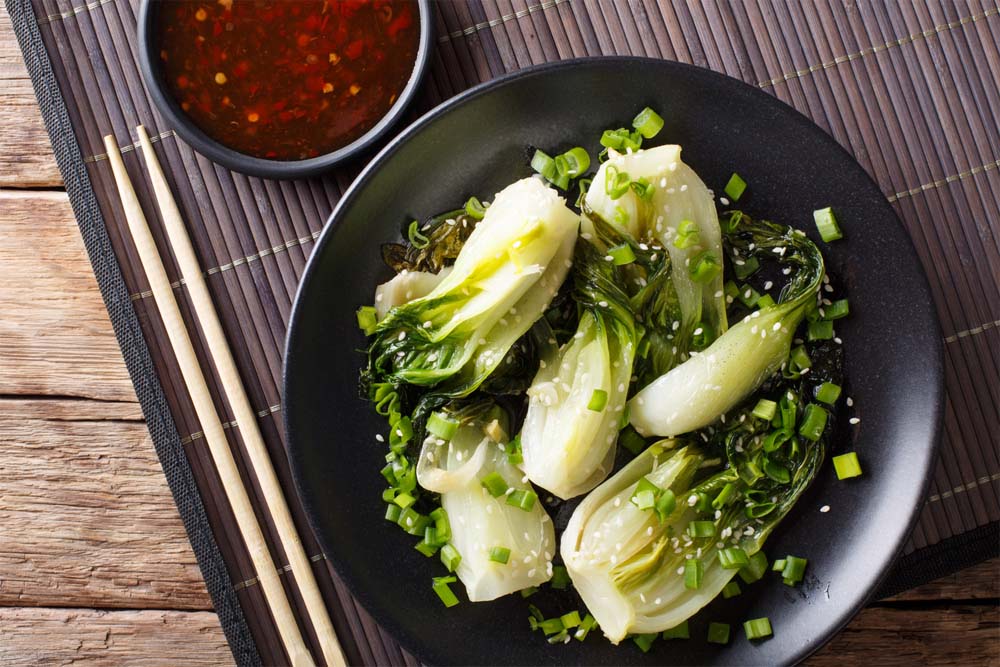
For this recipe, you’ll need the following ingredients:
- 2 Tablespoons canola oil
- 2 peeled, minced garlic cloves
- One half-inch piece of ginger root, peeled and minced
- Red pepper flakes to taste
- 4 bunches baby bok choy, with ends trimmed
- 1 tablespoon soy sauce
- 1 tablespoon chicken stock
- Toasted sesame oil
Prepare with the following steps:
- Use a sauté pan with a lid to to heat canola oil over medium-high heat until it begins to simmer, and then add garlic, ginger, and red pepper flakes. Cook, while constantly stirring, for 45 seconds.
- Add bok choy and stir the mixture carefully to cover the bok choy with oil. Cook for 2 minutes, add soy sauce and chicken stock. Cover the pan and cook for about two more minutes.
- Uncover the pan and and cook until the liquid is nearly evaporated, which will take about 3 more minutes.
- Remove the bok choy from pan and drizzle with sesame oil.
You can enjoy this recipe as a side dish along with chicken or another meat.
If you’re looking for ways to add more leafy greens to your diet, the recipes above are worth trying. In addition to using these recipes, you can make a habit of regularly throwing green leafy vegetables like kale into salads, smoothies, or eggs to easily incorporate them into your diet. You can find additional recipes on the Internet when you want to try something new.
The Bottom Line on Leafy Greens
Vegetable intake in general is important for health and nutrition, but leafy greens come with some unique health benefits. Incorporating more leafy greens into your diet is an excellent way to get the nutrients you need without adding excess fat, sodium, or calories to your diet. If you’re watching your weight or trying to manage a health condition, adding your favorite leafy greens to everyday dishes will deliver a healthy dose of micronutrients and fiber. This can keep your body systems functioning optimally and regulate blood pressure and blood glucose levels, reducing your risk of heart disease and diabetes.
For those already living with diabetes, it can be helpful to add leafy greens to your diet. These foods will add volume and crunch to your favorite dishes, making them more satiating and satisfying, while helping you to keep calories and carbohydrates in check. Filling your plate with these low-calorie vegetables can also assist with weight management and prevent complications like high blood pressure that can come from excess weight.
If you’re looking for additional support for managing diabetes, download Klinio diabetes app. It offers time-saving resources, such as personalized diabetes meal plans and at-home workouts, so you can make the lifestyle changes necessary for keeping blood sugar levels in check.
Take a quiz and get your diabetes-management plan today!







